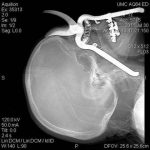Weird Trauma: Pruning Shears to the Head and Neck
This case made the national news yesterday, and I wanted to make a few comments on the ideal management of this type of injury.
An 86 year old Arizona man was trimming plants in his back yard and fell on his pruning shears. One of the handle grips pushed into his orbit and through his pharynx into his neck. How do you think through something like this?
First, always check vital signs. If the patient is hypotensive, they must go to the operating room. Even if vital signs are stable, ongoing bleeding necessitates an operation before anything else.
If vital signs are stable, then a road map showing vial structures is essential. The patient should be taken to CT so the exact position of the object can be determined. Any involved structures (carotid artery, esophagus) can be identified and a proper plan can be developed.
Then and only then can a stable patient be taken to the OR. Appropriate incisions should be placed so that key portions of the foreign object can be viewed as they are removed. In this case, incisions were made under his lip and into the maxillary sinus wall to monitor the removal process. The carotid artery had been cleared by CT. Once removed, any remaining bleeding can be addressed.
A final point: any problem like this that has the potential to involve the airway requires that a skilled anesthesiologist be present with appropriate airway management equipment, and the surgeon needs to have all equipment ready to place a tracheostomy on short notice.
This patient did well after removal and was treated with about 3 weeks of antibiotics for his sinus injuries. His inferior orbital wall was rebuilt, and overall he did well postoperatively. He is seriously reconsidering doing any gardening again.


